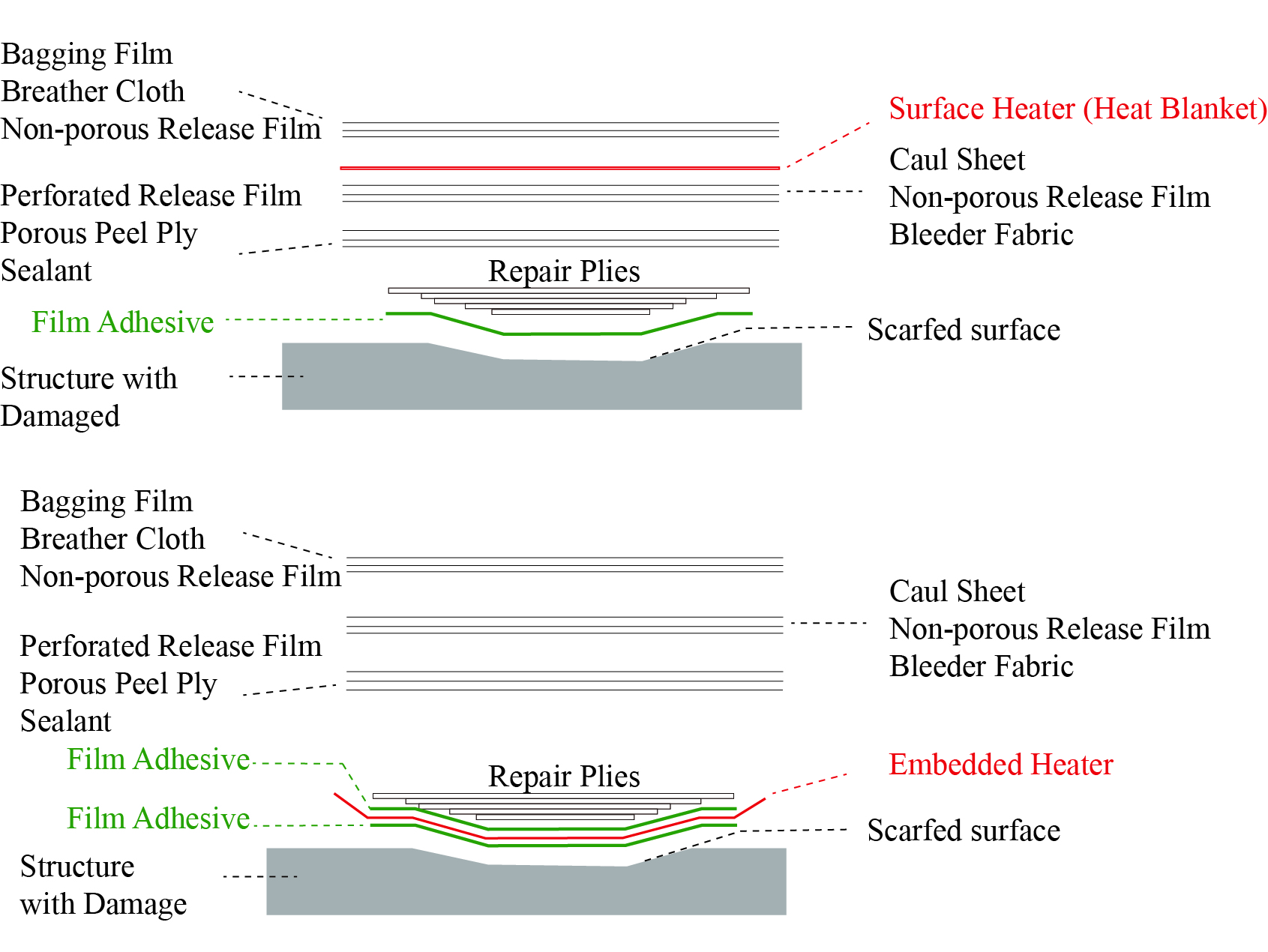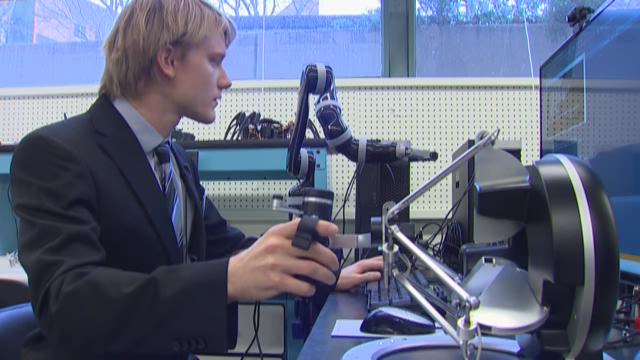|
|
Manufacturing
|
|
Our effort investigates novel out-of-autoclave techniques for composites manufacturing,
and
increasingly autonomous systems for advanced manufacturing applications.
|
Application 1: Robotics for Manufacturing
The
Boeing Advanced Research Center (BARC)
is a 4300 sq. ft. facility housed in the Department of Mechanical Engineering, College of Engineering at the University of Washington that fosters collaborative basic and applied research, translational research and development, and student education-related activities in the area of manufacturing and assembly of aircraft and spacecraft structures. These research and educational activities represent strong partnerships between UW and Industry.
The establishment of this facility represents a new paradigm in the execution of industrial research at UW in that Boeing-employed Affiliate Instructors will work in the lab, on a full time basis, hand in hand with faculty and students on joint research projects. It is envisioned that approximately eight Boeing-employed Affiliates will work concurrently in the lab with graduate students and that each project will have at least one UW faculty member assigned to it. The initial research focus is on automation, robotics, mechatronics and metrology, with the focus on the assembly of aircrafts, with four projects including predictive shimming, development of in-wing crawlers, inside fuselage automation for percussive rivet forming, and sensor fusion. The (BARC) is led by the Department of Mechanical Engineering; however, other departments in COE and UW will also be engaged.
Our groups effort is on automation, robotics, mechatronics and metrology, with the focus on the assembly of aircrafts, with projects including in-wing crawlers and inside fuselage automation. This is part of the
Boeing Advanced Research Center (BARC)
in the Mechanical Engineering Department at the U. of Washington.
For additional information on projects see (BARC)
and
the webpage on our Robotics Research
News on Boeing Advanced Research Center (BARC)
|
Application 2: Novel Embedded Heater for Composites Manufacturing and Repair
Research with Prof. Mark Tuttle.
Background: Composites have better strength-to-weight and stiffness-to-weight ratios when compared to metals, and therefore, composite structures enable aircraft to be more fuel-efficient. The increased use of high-strength Carbon Fiber Reinforced Polymers (CFRP) in passenger aircraft has resulted in an escalation of maintenance issues associated with composite structures. Hence, the repair of damage to composites has become an important issue in the aerospace industry. A common requirement is to rapidly repair a composite structure without removing it from the aircraft. Repair of thick structures while still on the aircraft can be difficult to achieve. For example, the thermal energy necessary to cure the repair adhesive must diffuse through the composite layers to reach the joint repair interfaces, resulting in long and expensive processing times as well as wasted energy. Surrounding heat-sensitive materials or equipment may also be damaged. The most popular approach to is to use a surface heater such as heat blanket(s) and/or heat lamps to generate the heat needed to cure the repair adhesive. In these approaches the entire structure is heated to initiate cure of the repair adhesive, typically a high-strength thermoset such as an epoxy. CFRPs typically exhibit poor thermal conductivities and consequently the temperature of the heated surface can be much higher than the temperature at the subsurface repair bondline. Large thermal gradients are inevitably created, resulting in an inefficient repair process.

Top: Schematic of current approach, which uses surface heating to cure the adhesive.
Bottom: Schematic of proposed approach with embedded heater to avoid the substantial through-thickness thermal gradient generated with surface heating.
Our main contribution
in Ref. 1 and Ref. 2 is to overcome the above difficulties by passing an electrical current through a carbon fiber fabric sandwiched between two layers of structural adhesive film and embedded in the bondline. The carbon fabric serves as an embedded a resistance heater. A substantial advantage of this approach is that the carbon fibers that initially serve as heating elements remain in the bondline as reinforcing materials. Since many types of carbon fibers have already been certified for use in transport aircraft (e.g., AS4 or IM7 fibers), which could facilitate certification of the proposed approach for use in commercial aircraft. The epoxy adhesive electrically insulates the embedded heater from the electrically conductive adherends. Moreover, it was shown in Ref 1 that bonded joints cured via an embedded resistive heating method have single-lap shear strengths comparable to the strengths of samples cured in an autoclave.
The technique could be applied to large scale composite repairs, or possibly employed during original manufacture of a bonded composite structure.
|
Application 3: Manufacturing of Graded-Index Polymer optical fibers (POFs).
Research with Prof. Ann Mescher and Prof. Vipin Kumar.
This NSF-funded effort aims to achieve desired properties of Polymer optical fibers (POFs) such refractive index and transmission (which are dependent on the POF’s cell structure) by controlling the processing of the POF.
It is noted that high-bandwidth (higher than Gigahertz) data transmission in graded-refractive index fiber is only possible with highly accurate control of the refractive index profile. An advantage of POF in comparison to (existing) glass optical fiber is the greatly reduced connection costs (2 - 3 orders of magnitude less).
Thus, the effort has the potential for universal broadband access at extremely low cost.
A novel process is being explored to tailor the POF properties --- gaseous carbon dioxide is diffused into a cylindrical polymer preform at elevated pressure, generating a non-equilibrium, supersaturated solution of carbon dioxide in the polymer and a resulting change in CO2 concentration as a function of the radial coordinate. The preform is then de-pressurized and heat-treated to create a specified POF cell structure. This permanently “locks-in” a desired change in refractive index as a function of the radial coordinate, and the preform is subsequently drawn into high performance fiber. Additionally, the research includes novel methods to control the CO2 diffusion process to enable precision control of the POF’s structure and property.
|
|
|
Contact Santosh Devasia:
devasia@u.washington.edu
|
|
|
|
Presentations and Videos
|
King5 News

News on Boeing Advanced Research Center (BARC)
|
References
Ref 1:
M. Ashrafi, S. Devasia, and M. E. Tuttle.
"Resistive Embedded Heating for Homogeneous Curing of Adhesively Bonded Joints."
International Journal of Adhesion and Adhesives, Vol. 57, pp. 34-39, 2015.
Pre-print
Ref 2:
B. P. Smith, M. Ashrafi, M. E. Tuttle, and S. Devasia “Bondline Temperature Control for Joining Composites with an Embedded Heater,” ASME Journal of Manufacturing Science and Engineering, Vol.138 (2), Article number 021011, pp. 1-9, February 2016.
For additional references see
Webpage on our Robotics Research
|
|



